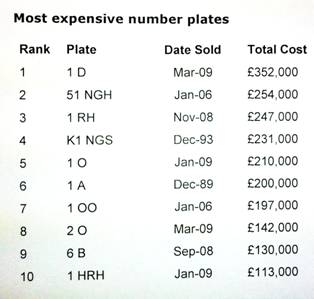Select registrations contribute £1.8bn to the economy

DVLA plays a major role within the number plate industry and since 1989, it has raised £1.8 billion for the Treasury purely from the sale of registration numbers via its auctions and website.
The Agency began selling select registrations during the 1980s when it became clear that the sale of sought-after combinations were being traded for significant sums of money. To capitalise on this, DVLA began to reserve certain registration numbers, such as those that resemble names or words, and combinations containing less characters, in order to lodge them in future auctions.
Hundreds of thousands of new combinations are released each year. The majority are put up for sale on their website, whereas the most desirable ones are also reserved for the future auctions, aiming to sell them for their true market value.

What are the available styles and where can I get them?
There are four different types available, and the format is based on registration numbers issued in different eras.
- Current style – (2001-present) – Example: AB51 ABC
- Prefix style – (1983-2001) – Example: A123 ABC
- Suffix style – (1963-1983) – Example: ABC 123A
- Dateless – (pre-1963) – Example: 1 AB or 1234 AB
Dateless registration numbers consist of combinations of up to four numbers followed by up to three letters, or vice-versa. This style tends to be the most popular as they can go on any age vehicle and ultimately covers up its real age. These will only be found in the DVLA auctions and/or advertised with number plate dealers such as Carreg.co.uk
The rest are age related numbers, so you can distinguish when it was issued by the ‘age identifier’. For the current style, the two-digit number is the age identifier, for the prefix it is the first letter, and for the suffix it is the last letter of the combination. For example:
- In a current style, ‘61’ means it was issued between 01/09/11-29/02/12;
- In a prefix style, the ‘A’ means it was issued between 01/08/83-31/07/84;
- In a suffix style, the ‘A’ means it was issued between 01/02/63-31/12/63.
Current styles and Prefix styles can be found on the DVLA website, and/or with number plate dealers such as Carreg but some of the more desirable ones may be in the DVLA auctions also.
Suffix styles will normally only be advertised with dealers and/or in the DVLA auctions.
For more information regarding DVLA Number Plates please see the Carreg page at http://www.carreg.co.uk/dvla-number-plates/
Comments
Compare classic car insurance quotes and buy online. A friendly service offering access to a range of policies and benefits.


 Keith Adams
Keith Adams
 NEC classic motor show 2020 postponed due to Covid 19 concerns
NEC classic motor show 2020 postponed due to Covid 19 concerns
 Classic car auction house Coys goes into administration
Classic car auction house Coys goes into administration
 Motor racing great Sir Stirling Moss dies aged 90
Motor racing great Sir Stirling Moss dies aged 90
 Alfa Romeo anniversary races set for Silverstone
Alfa Romeo anniversary races set for Silverstone
 Government to make E5 fuel available for classic owners
Government to make E5 fuel available for classic owners
 Plans to introduce cleaner fuel could damage more than a million classic cars
Plans to introduce cleaner fuel could damage more than a million classic cars
 Top 10: Classic cars from the Gulf motor racing heritage collection
Top 10: Classic cars from the Gulf motor racing heritage collection





Add a comment